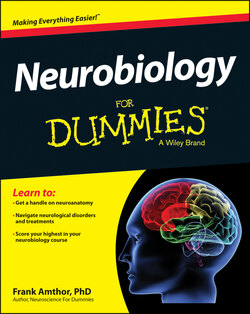Читать книгу Neurobiology For Dummies - Frank Amthor - Страница 94
Ion-selective channels
ОглавлениеIon-selective channels, as their name implies, control the movement of certain ions through plasma membranes. These channels are typically composed of four or more individual proteins (called subunits) that combine in the membrane to form a molecular pore. Most ion channels are selective — they only allow certain ions to pass and, often, only in one direction.
Ion channels can be un-gated or gated:
Constitutively open channels: These are sometimes called leakage channels and are just like your reliable corner store because they’re always open. Their permeability (ability to pass ions) is not modulated. However, the number of these channels in the plasma membrane (and, thus, the total membrane permeability) is controlled by DNA expression. This way, total permeability may be modified.
Gated channels: These channels can be open or closed. Controlling ion movements through gated channels is fundamental to how neurons receive, process, and transfer information. Sensory receptors activate channels by receiving energy such as light or sound, or by external substances such as odors. Neurons communicate with other neurons through two types of gated channels: Ligand-gated channels are channels that are opened as a result of a molecule (typically a neurotransmitter) outside the cell binding to a complementary receptor structure inside the channel complex. (The word ligand is from a Latin word meaning “to bind.” ) In ionotropic receptors (see Chapter 4 for more), the ligand binding site and gated pore are part of the same membrane protein complex. In metabotropic receptors, after binding a ligand, the receptor protein complex in the membrane activates a second messenger transmitter inside the cell whose actions may open or close other channels.Voltage-gated channels open in response to changes in membrane potential, which is the voltage difference between the inside and outside of the cell. Typically, voltage-gated channels are closed when the neuron is not excited (at the “resting potential”) and open when the cell is excited. When the neuron is excited (or stimulated), the membrane potential is depolarized (or more positive).
